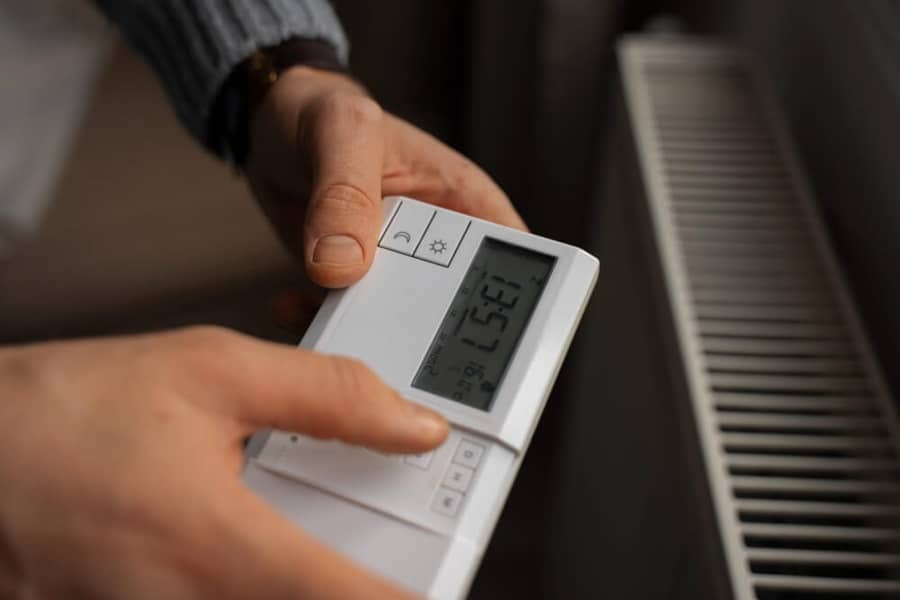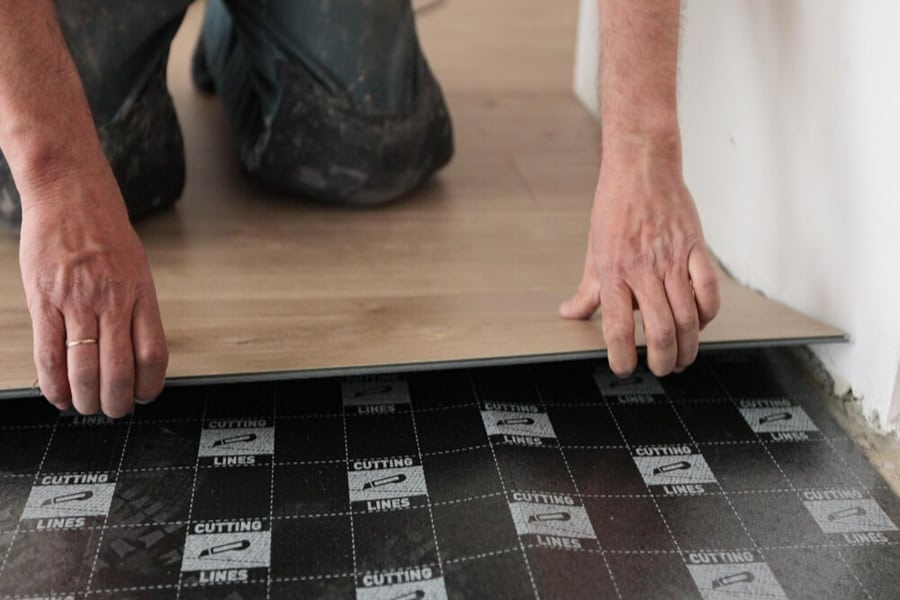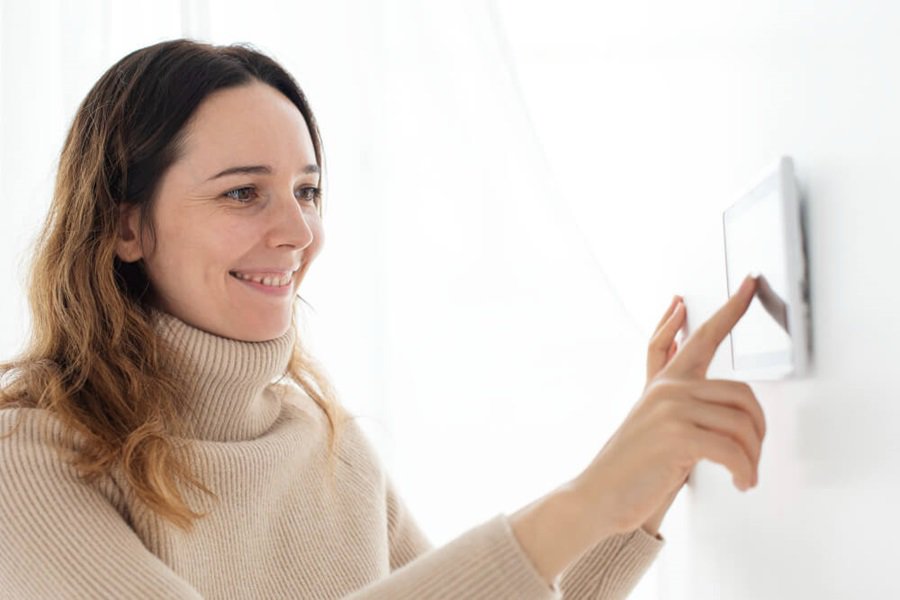Wondering about managing your underfloor heating system, especially during the warmer seasons?
Knowing how to turn off underfloor heating (and turn on, too) is critical for homeowners looking to manage their bills more effectively during warmer months in the UK. In this article, we’ll delve into how to turn off underfloor heating as the weather warms up and how to turn it on when the chill returns. Efficiently operating your system not only saves energy but also extends its lifespan.
Should You Turn Off Underfloor Heating In The Summer?
Underfloor heating systems offer an efficient and low-maintenance way to warm your home. They are discreet and effective, removing the need for bulky radiators and providing extra space in your rooms.
This system is not only about comfort but also about health, as the consistent warmth reduces the presence of dust mites, beneficial for those with respiratory issues. With modern day smart thermostats, these allow for precise temperature management, tailoring your home’s warmth to your exact preference, as well as the ability to control underfloor heating from your phone.
You can learn more about the impact of heat and asthma with us.
Benefits of Turning Off Underfloor Heating in the Summer

Turning off your underfloor heating (UFH) during the summer can lead to significant energy savings. Keeping the system active throughout these warmer months could result in unnecessary energy consumption, increasing indoor temperatures and possibly requiring additional cooling methods like fans or air conditioning, which further escalates energy costs.
Moreover, operating your UFH system continuously during the summer may incur higher maintenance costs and strain the system, reducing its lifespan. For water underfloor heating systems, it’s advisable to activate them briefly every two weeks for up to 20 minutes to prevent any operational issues and ensure the system remains functional.
How to Turn Off Underfloor Heating
Switching off your UFH system involves a simple process. Initially, you should turn off your underfloor heating control systems (thermostat) to stop heating. Following this, locate and switch off the power supply to the system to ensure it is completely deactivated. For those with water underfloor heating kits, be sure to contact us on whether to drain the system, especially in areas prone to freezing temperatures, to avoid any damage during inactive periods.
Cooling Down Period for Underfloor Heating
The time required for an underfloor heating system to cool down can be up to 24 hours, varying with the flooring material. Stone, tiled, porcelain or ceramic floors will retain and emit heat longer due to their high thermal density, compared to wooden or carpeted floors. This attribute means that such materials also take longer to warm up when the heating is reactivated.
Switching Off Underfloor Heating For Maintenance
Maintaining optimal function through regular checks and appropriate actions when you have turned off your underfloor heating system ensures that it operates efficiently, reducing the likelihood of issues, minimising costs, and providing reliable warmth and comfort in your home over time.
- Regular Surface Cleaning: Maintain the cleanliness of your underfloor heating system by ensuring that no debris, dust, or objects interfere with the airflow or heat distribution. Keeping the surface clear helps in maintaining efficient heat flow.
- Manifold Leak Inspection: Routinely check your underfloor heating’s manifold for any leakage. Most underfloor heating systems feature a continuous piping loop where leaks are most likely to occur at the manifold. Address detected leaks immediately to avoid further system damage.
- Thermostat and Control Checks: Verify that the thermostat and control mechanisms are operational. If your system uses a wireless thermostat and isn’t responding, inspect and replace the batteries as necessary.
- System Flushing and Flow Balancing: Accumulated sediments or debris in the pipes can impede your system’s efficiency. Flushing the system with an appropriate cleaner can remove these obstructions. Balance the flow rates across different heating zones to ensure uniform warmth in all areas.
- Anti-Corrosion Measures: Enhance your system’s longevity by adding an inhibitor to curb bacterial and sludge formation, extending the interval between flushes to up to four years. Hire a professional to assess the inhibitor concentration by extracting a sample from the system, similar to radiator maintenance. Incorporating a magnetic filter on the boiler’s flow pipe can also capture ferrous particles, benefiting both underfloor and radiator heating systems.
- Valve and Manifold Inspection: Regularly examine the manifold and valves for wear, corrosion, or leakage. Secure any loose components and replace damaged parts as needed.
- Performance: Stay alert to changes in heating efficiency, such as inconsistent warmth or diminished heat output. These symptoms could signal problems that necessitate expert evaluation.
How To Turn On Underfloor Heating
Reactivating your underfloor heating (UFH) system as the cooler weather sets in is a straightforward process, especially if you’ve been powering it on briefly every few weeks during the summer. To bring your system back to life, simply turn on the power and adjust the thermostat. Ensuring the thermostat functions correctly is crucial for maintaining the desired temperature.
Checking Your System Before Reactivation
For water-based UFH systems that have been dormant throughout the summer, inspect for potential leaks before fully reactivating. Once everything appears to be in order, activating the system can take a few hours to warm up the space thoroughly.
Initial Activation of New Underfloor Heating
Ensure to be patient if you are firing up your newly installed UFH for the first time. As such, the screed—the layer beneath your flooring material – should be completely dry. Turning on the heating too soon can cause damage, like cracking, due to moisture trapped in the screed. The drying times can vary, so consulting with us for specific guidance is essential.
How long does it take for screed to dry? Find out now.
Best Flooring For Underfloor Heating

The type of flooring over your UFH affects how you should activate the heating. For instance, timber floors require a gradual increase in temperature to prevent warping or damage. It’s important to follow the flooring manufacturer’s instructions to ensure compatibility with underfloor heating.
Timber Flooring
For timber floors, gradual heating is essential to prevent damage. Start by setting the heating mixing valve or heat pump to around 40°C, then increase the temperature by 5°C daily until the desired warmth is achieved. This slow process minimises the risk of warping or stressing the wood with underfloor heating on timber floors.
Stone and Ceramic Tiles
Stone and ceramic floors, known for their heat resistance, tolerate higher temperatures without the sudden changes that affect timber. However, installing a decoupling membrane beneath these tiles can prevent potential heat-induced damage. Always verify the maximum temperature tolerance with your tile manufacturer to ensure safe and effective heating.
Vinyl and Linoleum Flooring
Vinyl flooring with underfloor heating can work just as well as other flooring types. Vinyl and linoleum should be acclimated to the room’s natural temperature, typically between 18–26°C, before installation. Turn off the UFH 48 hours before laying these materials and keep it off for another 48 hours post-installation. The adhesive used should withstand the underfloor heating’s operating temperature, usually up to 27°C.
Carpeted Floors
Carpets require the underfloor heating to be off 48 hours before and after installation. Subsequently, gradually increase the temperature over a week to reach the system’s full capacity. Ensure that the adhesives and underlay are compatible with the UFH’s heat output.
Reactivating After a Prolonged Shutdown
If your UFH system has been off for an extended period, such as over the summer, it’s advisable to reintroduce heat gradually. This approach helps acclimatise the flooring material to the changing temperature, preventing stress and damage.
Temperature Settings
Understanding the ideal temperature settings for your specific flooring type can improve the efficiency and longevity of your UFH system. Gradually increasing the temperature allows the floor to adjust and ensures even heating across all areas.
Troubleshooting
After a summer hiatus, electric underfloor heating systems typically resume without hitches, while water-based systems might encounter difficulties. A common issue is a malfunctioning thermostat or a problematic circulating pump. Resetting the thermostat often resolves the former, while the latter might necessitate professional inspection. Sticking pin valves can also cause operational failures; these can be loosened with lubricant or mechanical adjustment.
Maintain Underfloor Heating By Turning It Off

In summary, managing underfloor heating effectively involves knowing how to turn off and turn on the system seasonally, maintaining optimal temperature settings for different flooring types, and addressing any post-summer operational issues. By following these guidelines, you can improve the efficiency and longevity of your underfloor heating, ensuring a comfortable and cost-effective home environment.
Sometimes it’s not just learning how to turn off underfloor heating. What about normal heating systems? Learn when to put on central heating throughout the year.
FAQs
Can you switch off underfloor heating?
Yes, you can switch off underfloor heating manually using the system’s thermostat or control panel, depending on the installation.
Why does my underfloor heating not turn off?
If your underfloor heating does not turn off, it could be due to a malfunctioning thermostat, a stuck valve, or a problem with the control system.
Can you disconnect underfloor heating?
You can disconnect underfloor heating, but it should be done by a qualified electrician or heating specialist to ensure it is done safely and without damaging the system.
How do you turn down underfloor heating?
To turn down underfloor heating, adjust the thermostat to a lower setting or use the control system to reduce the temperature or heating schedule.
Sources
Babington-Stitt, T., (2023) It’s getting hot in here – or is it? This is when you should be turning your heating on this year. Ideal Home. [online] Available at: https://www.idealhome.co.uk/news/when-to-put-central-heating-on-287914 [accessed 09/04/24]
